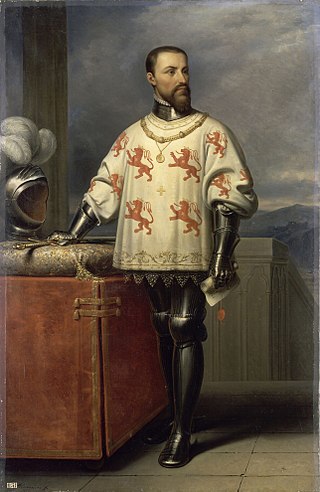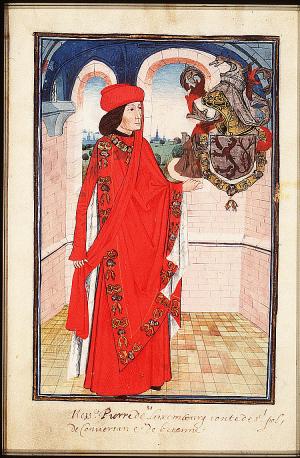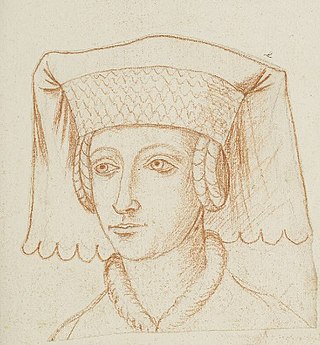
Ludovico I or Louis I was Duke of Savoy from 1440 until his death in 1465.

The House of Ibelin was a noble family in the Crusader Kingdom of Jerusalem in the 12th century. They rose from relatively humble beginnings to become one of the most important families in the kingdom, holding various high offices and with extensive holdings in the Holy Land and Cyprus. The family disappeared after the fall of the Kingdom of Cyprus in the 15th century.

Louis of Enghien titular Duke of Athens, Count of Brienne and Lord of Enghien in 1381–1394, Count of Conversano in 1356–1394.

Marie of Luxembourg-Saint-Pol was the ruling Countess Regnant of Soissons and Saint-Pol between 25 October 1482 and 1 April 1547. She was additionally made Countess consort of Vendôme through her marriage to Francis, Count of Vendôme. After the death of her husband, she became regent of the County of Vendôme as the guardian of her son, Charles de Bourbon.

Louis de Luxembourg, Count of Saint-Pol, of Brienne, de Ligny, and Conversano belonged to the Ligny branch of the House of Luxemburg and was Constable of France.

Anne of Cyprus was a Duchess of Savoy by marriage to Louis, Duke of Savoy. She was the daughter of King Janus of Cyprus and Charlotte of Bourbon; and a member of the Poitiers-Lusignan crusader dynasty. She was highly influential in the Duchy of Savoy and acted as the political advisor and the de facto ruler on the wish of her spouse.

Peter II was Count of Saint-Pol, of Brienne, Marle, and Soissons.
Margaret of Baux was a Countess of Saint-Pol, of Brienne, and of Conversano. She was a member of the noble House of Baux of the Kingdom of Naples, which had its origins in Provence dating back to the 11th century. Her husband was Peter of Luxembourg, Count of Saint-Pol, of Brienne, and of Conversano.
Jeanne de Bar, suo jure Countess of Marle and Soissons, Dame d'Oisy, Viscountess of Meaux, and Countess of Saint-Pol, of Brienne, de Ligny, and Conversano was a noble French heiress and Sovereign Countess. She was the only child of Robert of Bar, Count of Marle and Soissons, Sire d'Oisy, who was killed at the Battle of Agincourt when she was a baby, leaving her the sole heiress to his titles and estates. In 1430, at the age of fifteen, Jeanne was one of the three women placed in charge of Joan of Arc when the latter was a prisoner in the castle of John II of Luxembourg, Count of Ligny, Jeanne's stepfather.

Margaret of Savoy, also known as Marguerite de Savoie or Margherita di Savoia, was the eldest surviving daughter of Louis I, Duke of Savoy. She was the wife of Margrave John IV of Montferrat, and later the wife of Peter II of Luxembourg, Count of Saint-Pol, of Brienne, Marle, and Soissons.

Marguerite d'Enghien, was the ruling suo jure Countess of Brienne and of Conversano, suo jure Lady of Enghien, and Lady of Beauvois from 1394 until an unknown date.

Peter of Luxembourg was count of Saint-Pol. His inheritance included the counties of Brienne, Conversano and Saint-Pol.
Jeanne de Béthune, Viscountess of Meaux, Countess of Ligny, was a French noblewoman, the suo jure Viscountess of Meaux, having inherited the title upon her father's death in 1408. Her father was Robert VIII de Béthune, Viscount of Meaux. Jeanne married twice; firstly to Robert of Bar, and secondly John II of Luxembourg, Count of Ligny who held Joan of Arc prisoner following her capture by the Burgundians in May 1430. Jeanne was one of the three women who cared for Joan during her imprisonment.
Marie or Mary of Brittany may refer to:
Guy I of Luxembourg-Ligny was Count of Saint-Pol (1360–1371) and Count of Ligny, Lord of Roussy and Beauvoir (1364–1371).

Anthony I, Count of Ligny (1450–1519) was the youngest son of Louis de Luxembourg, Count of Saint-Pol and his wife, Jeanne de Bar, Countess of Marle and Soissons. In 1482, he inherited the County of Brienne from his brother Peter II, Count of Saint-Pol. After the death of Charles of Bourbon in 1510, Anthony inherited the County of Ligny, which thereby fell back to the House of Luxembourg.
Robert of Bar was Lord of Marle between 1397 and 1413, Count of Marle between 1413 and 1415 and Count of Soissons between 1412 and 1415.

John of Luxembourg, was Lord of Beauvoir and Richebourg, and also Count of Brienne and Conversano.
John III, Count of Ligny was the eldest son of Count Anthony II and his wife Margaret of Savoy. He succeeded his father as Count of Brienne and Ligny in 1557.











